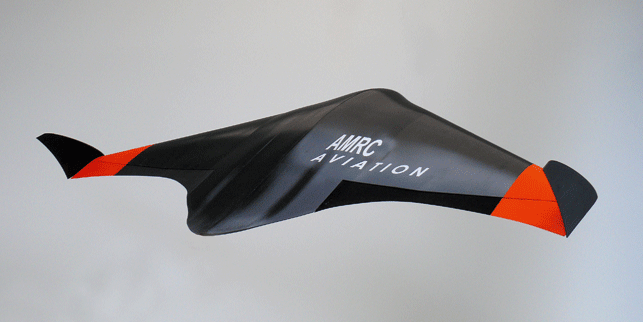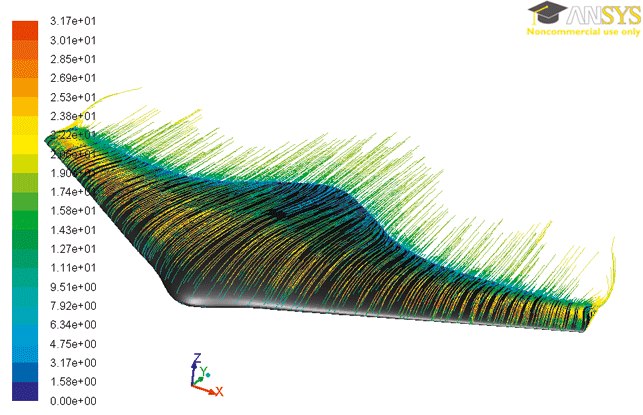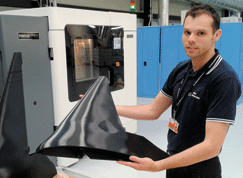The recent increase in the use of both additive layer manufacturing and Unmanned Aerial Vehicles (UAVs) has led to the availability of a number of 3D printed UAVs for a range of applications.

The UAV airframe was 3D printed in ABS plastic using FDM technology
Small wingspan, fixed wing aircraft are used for applications ranging from hobby flying to reconnaissance and humanitarian aid. Key drivers in the development of these vehicles are manufacturing lead time and cost, with additional focus on ease of assembly.
With this in mind, the Advanced Manufacturing Research Centre’s new Design and Prototyping Group (DPG) at the University of Sheffield undertook an internal project to design and build a low cost UAV airframe in ABS using its Stratasys Fortus 900mc Fused Deposition Modelling machine.
Best process for the job
For printing relatively large components such as a UAV airframe, FDM technology was chosen over stereolithography (SLA) and selective laser sintering (SLS) for its lower initial investment, material cost and simplified process.
“By understanding the capability of the FDM process and associated software, we were able to manipulate the design to contain a number of unique features as well as preventing build deformation,” explains DPG’s additive manufacture development engineer Mark Cocking.

Using Ansys CFD software the engineers optimised the chosen airframe design
“All parts required for the airframe can be combined onto a single build within the DPGs Fortus 900 machine, taking less than 24 hours with ABS-M30 material. Before design for additive manufacture optimisation, this airframe would have taken over 120 hours to produce.”
Evaluating the design
With these constraints in mind, a number of conceptual CAD models were created for evaluation. A range of configurations, sweep angles, chord lengths, taper ratios and aerofoil sections were considered.
“The whole airframe was designed specifically for additive manufacture. The optimum configuration for the diverse requirements of aerodynamic performance and FDM manufacture appeared to be the blended-wing-body.
“This type of design has a number of advantages. Primarily for this project, it lends itself to FDM technology due to the smooth leading and trailing edges over each half-span,” explains development engineer John Mann, who was responsible for detail design and CAD modelling of the aircraft.
Computational Fluid Dynamics (CFD) was used to optimise the chosen design and to assess the lift, drag, pitching moment and other characteristics over a range of angles of incidence.
The FDM process also allowed the design to incorporate swept wings with straight leading edges, suited to the low Mach number flight regime the UAV would operate in.
The airframe comprises just nine parts, all of which are built using the FDM process: Two wings, two elevons, two spars, two wing end fences and a central spine. None of these components require support material during build.
Strong structure
The aircraft was designed to split into two halves about the central spine. This configuration allowed a larger wingspan to be built within the FDM machine’s build envelope, and made transportation easier.
A pair of short spars (front and rear) clip into sockets formed within each wing half, giving a rapid set-up time for flight. The airframe has a wingspan of 1.5 metres, and weighs under 2kg.
The internal structure of the wings is a semi-monocoque which has to serve a number of purposes including: withstanding distortion as the build height increases during manufacture; withstanding aerodynamic loads during flight, especially in manoeuvres; and, due to the requirement to minimise fixings, the structure has to incorporate a solution for ease of assembly of the two wing halves.
In this case, two locating spars are used to snap the wings together without any additional fixings, while adding rigidity and strength to counteract launch and flight loads.
In order to prove the design, the UAV was flight tested as a radio controlled slope soaring glider. The aircraft showed good stability, and low aerodynamic noise at speed indicated an efficient wing design.
So far this project has demonstrated that design for manufacture of relatively large, thin walled parts can be optimised for the FDM process such that only build material is required without any support structure, thus giving considerable manufacturing time and cost savings.
“Not only did the AMRC team set themselves a tough challenge but their success clearly showed the power of having a detailed understanding of both the FDM technology and the importance – specifically – of design for manufacture,” comments Mark Tyrtania, sales director of Laser Lines, which is a Stratasys’ Platinum Partner and the UK supplier of AMRC’s Fortus 900.
amrc.co.uk
laserlines.co.uk
UAV design and manufacture with 3D printing
Default







